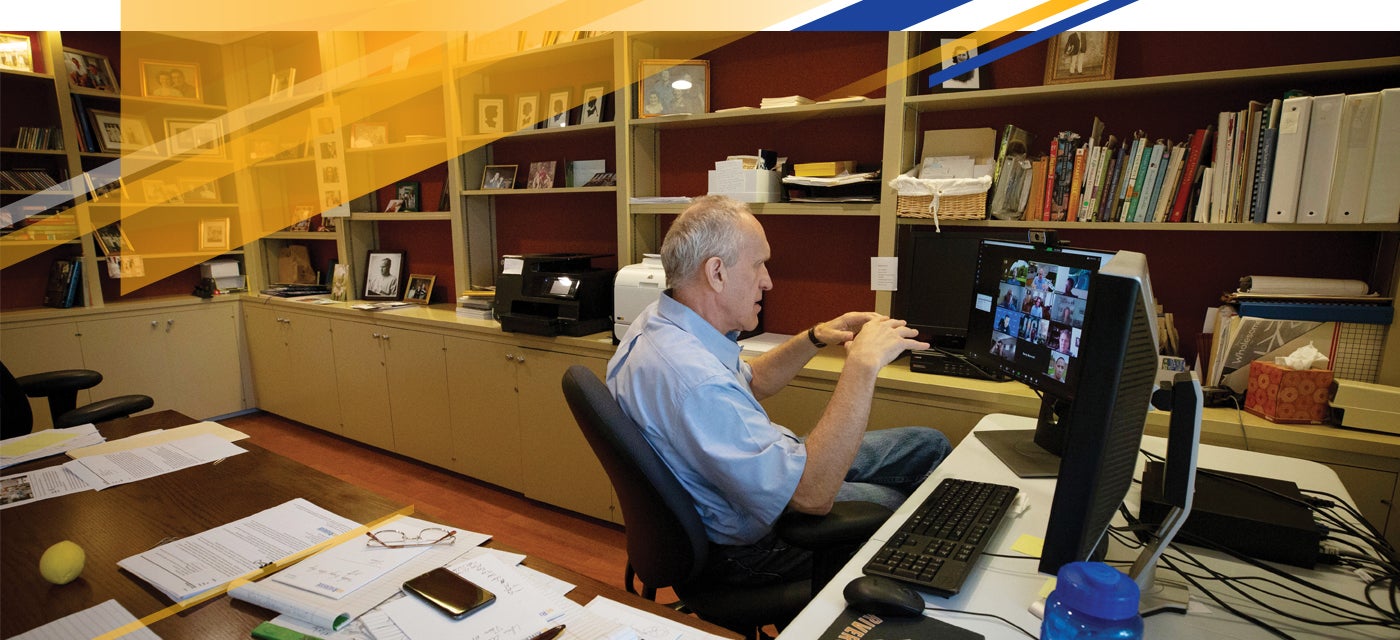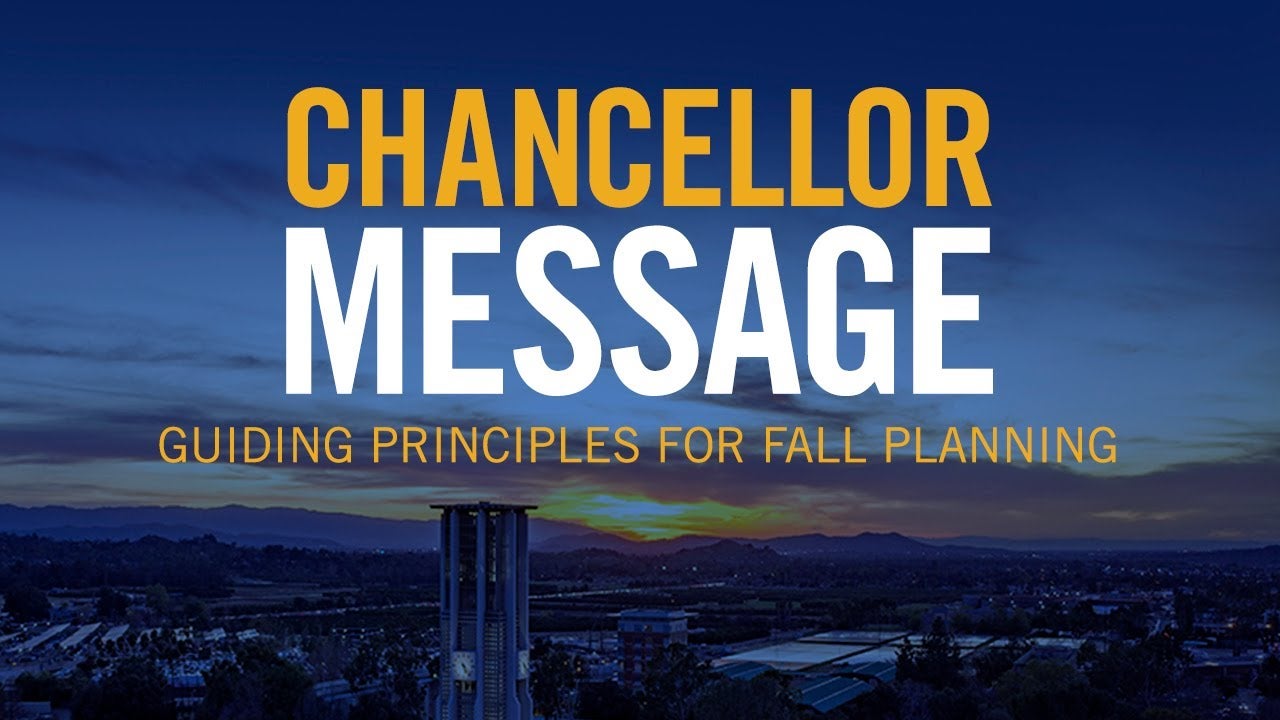By Imran Ghori
UC Riverside Chancellor Kim A. Wilcox won’t soon forget the events of Friday, March 13, 2020, the day Riverside County authorities directed all schools and colleges to close by the following Monday.
“We had the weekend,” Wilcox recalled with a wry laugh.
An announcement went out the next day instructing employees that most would be working from home for the foreseeable future. A decision to hold winter quarter finals online had already been made earlier that week. Now, four months later, the campus remains mostly empty except for the employees performing critical operations. By this point, students, instructors, and staff have become used to attending classes or meetings with co-workers on Zoom from their homes as part of their daily routines — but it took an enormous amount of work to get here. Wilcox, who hasn’t been back to his office on the fourth floor of Hinderaker Hall since March 13, marveled at how the campus community has managed the shift.
“I can tell you it was a Herculean effort,” he said. “To think of one class moving online is a huge endeavor. To do the entire curriculum for the entire campus in one fell swoop was huge.”
Before the storm
UCR’s Environmental Health & Safety department, or EH&S, began seriously monitoring the coronavirus situation in January when the first cases of COVID-19 were reported in the United States. Campus emergency management and health officials began holding regular meetings to discuss the campus’ preparedness and response.
“There wasn’t a day where we sat down and said, ‘OK, things have changed,’ because it was incremental and happening so fast,” Wilcox said. “It’s kind of a blur when you think back to those days before March 13.”
Sheila Hedayati, executive director of EH&S; and Dr. Kenneth Han, chief medical officer at the Office of Student Health Services; used those morning huddles to stay updated on the latest reports and scientific data. They also started discussing safety measures to minimize the campus’ exposure.
“We just knew this was coming and this was similar to H1N1,” Hedayati said, referring to the 2009 virus also known as the swine flu.
Han’s office began issuing advisories providing basic information about the coronavirus, what scientists knew about the symptoms, and tips to avoid getting infected such as practicing good hygiene. On Jan. 30, University of California President Janet Napolitano halted nonessential travel to China. By the beginning of March, the seriousness of the situation had grown, with UCR officials starting to make preparations for a possible closure or the need to quarantine segments of campus. The UC travel ban was extended to all international trips. But even then, campus leaders thought any disruption would only be short-lived. On March 10, Wilcox and Interim Provost and Executive Vice Chancellor Thomas Smith announced winter final exams would not be held in person, and the first week of spring quarter would be conducted remotely. Students living on campus were told they could return home during that period.
“We knew we had a little bit of time to make a call on the spring quarter,” Wilcox said, referring to the weeklong spring break after finals. “Most of us were seeing we would probably have to go remote at that point.”
By the end of the week, the decision was made for them as the county’s public health order came down. As more data from health officials came to light, there was no question about it being the correct decision, Wilcox said.
Chancellor Kim A. Wilcox working from his home office on May 13. (Photos by Stan Lim/UCR)
Puzzle pieces
Moving to remote instruction (see page 12) was only one piece of the puzzle. Those morning EH&S meetings turned into daily huddles as leaders worked out the logistics of ramping down on-campus activity. The participants expanded to include vice chancellors and others overseeing the various operational departments.
“We couldn’t make a decision about the research labs that wasn’t informed by the physical plant capability,” Wilcox said. “We couldn’t make a decision about the residence halls that wasn’t informed by student health and safety. Everybody had to be part of the conversation.”
Research operations all over campus were halted — an unprecedented and difficult decision due to its impact on a wide variety of activities from science laboratories to agricultural operations. All campus restaurants and residential dining halls were closed except for the Market at Glen Mor and Lothian Residential Restaurant. Both continued to feed students still living in campus housing with Lothian closing later in March as the number of student residents dropped. UCR typically provides housing to more than 6,600 students in campus residence halls and apartments. Those who could were encouraged to leave campus. Within a few weeks after the campus closure, 92% of residence hall contracts had been canceled, representing roughly 3,000 students. Meanwhile, another 55% of campus apartment leases were canceled, adding up to about 1,600 students. Some who couldn’t easily go home or didn’t have anywhere to go remained on campus. Those who stayed were consolidated into one building while the other student housing buildings were closed. A reduced force of housing and dining employees serving those students were among the critical employees continuing to work on campus. Others included police officers patrolling the campus, Facilities Services staff maintaining the Central Plant, and EH&S workers monitoring research labs. In addition to the morning huddles, Wilcox held regular briefings with a smaller group of campus leaders and separate meetings with Napolitano and other UC chancellors to discuss the systemwide response.
“Eighty percent of my time was on COVID,” Wilcox said. “It was 10 hours a day for seven days. It was all-consuming. Everything the university does was affected.”
The unknowns surrounding the pandemic meant responding to changing circumstances as new information came to light. For instance, face coverings were not initially recommended by public health officials. But on April 4, the Riverside County public health officer issued an order requiring face coverings when out in public. EH&S immediately put together a policy for on-site campus employees and distributed masks to them that weekend.
The new normal
On a warm spring day at the end of April, Wilcox sat at a patio table in his backyard on a Zoom call for his meeting with the provost, vice chancellors, and faculty leadership, now held every Wednesday at noon. By that point, the morning meetings with department heads were held only a couple of times a week. Wilcox convened with the other UC chancellors and Napolitano twice a week.
“We’ve worked explicitly to try to get back to a normal operation, my day included,” Wilcox said.
Wilcox spent most of his time in his home office glued to the two large computer screens on his desk. He often rides his bike for exercise in the evenings.
“It’s good to get out but also keep track of what’s going on around campus,” he said.
The campus had shifted away from emergency planning and had somewhat settled into the new mode of operation. Discussions focused on planning for the summer and fall quarters. The afternoon’s leadership meeting involved figuring out how to handle COVID-19 testing on campus. With thousands of students and employees, could UCR put together a system for quickly testing them? How long would it take to get results? Where on campus would it be done, and could it be accomplished in time for fall? Campus leaders, including Dr. Deborah Deas, vice chancellor for health sciences and dean of the School of Medicine; and Gerry Bomotti, vice chancellor of Planning, Budget and Administration; outlined some possible solutions and challenges. They and others noted the issue was not only the initial testing, but ensuring the campus had the capacity to conduct it in a sustained way.
“We’ve got to get after it as intensely as we can and at least make the judgement of whether this is viable and how,” Wilcox said during the meeting.
Those and other decisions, he said, would be guided by the same principles of gathering as much information as possible and protecting the health and safety of the campus community. A week earlier, the campus had announced it would postpone on-campus commencement ceremonies planned for June because it would not yet be safe to hold those events, which draw around 6,000 graduates plus many more family members and friends, Wilcox said. Students would, however, be honored with an online celebration in June.
“It was hard to share that with students who were very much looking forward to those events,” Wilcox said.
By June, campus planning for the fall had progressed. Several working groups had been meeting to discuss what would be involved in allowing more students, staff, and faculty members back on campus. Each group looked at a different aspect such as research, operations, student instruction, and budget.
“There’s so many different parts to it, it just wasn’t reasonable to think any one group would have the expertise or ability to answer all the questions,” Wilcox said. “We’ve got some guiding principles that we’ve tried to use for as much of our decision-making as possible with a primacy on health and safety, of course.”
On June 8, the campus began allowing some research to resume under a plan created by the Research Ramp-up Group. Researchers were required to create a plan outlining how they would implement safety procedures such as physical distancing, disinfecting shared spaces, and maintaining logs for contact tracing. Wilcox described it as a slow ramp-up, noting each laboratory is specialized with researchers who have different needs. On June 17, a plan developed by the Instructional Continuity Working Group was announced in which all classes would continue to be available in remote formats at least through the fall quarter, and any class approved to be offered in person will also accommodate students wishing to take the class remotely. It was not yet clear which classes would have an in-person option.
The bottom line
The state budget, and what it would mean for the UC system, dominated conversation during the campus leadership meeting in early June. A May proposal by Gov. Gavin Newsom included a 10% cut to the UC system, but state officials did not expect a clear picture of the budget until August.
“It’s another one of those huge unknowns that we continue to face,” Wilcox said, noting UCR’s goals would remain the same despite those challenges.
“We have the same aspirations,” he said. “We still want to maintain our national leadership role in research and education. Those things remain priorities.”
Over the last few months, Wilcox and other campus leaders held virtual office hours, and the chancellor began regularly popping in to classes and other campus group Zoom meetings to chat with students, faculty, and staff members about how they were doing.
“They’ve been some of the best parts of the quarter for me,” he said of his more than 50 pop-ins. “I’ve had a chance to see and meet and talk with a lot of people. I’ve learned a lot. They’ve been very helpful experiences for me.”
Wilcox said he’s impressed with how the campus has pulled together and supported one another even while the community remains apart.
“We’ve learned we’re very resilient, amazingly so,” he said. “I think we’ve reminded ourselves of how committed we are to each other. That’s students to faculty, faculty to students, each group to every other group on campus.”




